stop start RENAULT DUSTER 2016 Owner's Guide
[x] Cancel search | Manufacturer: RENAULT, Model Year: 2016, Model line: DUSTER, Model: RENAULT DUSTER 2016Pages: 256, PDF Size: 6.49 MB
Page 168 of 256
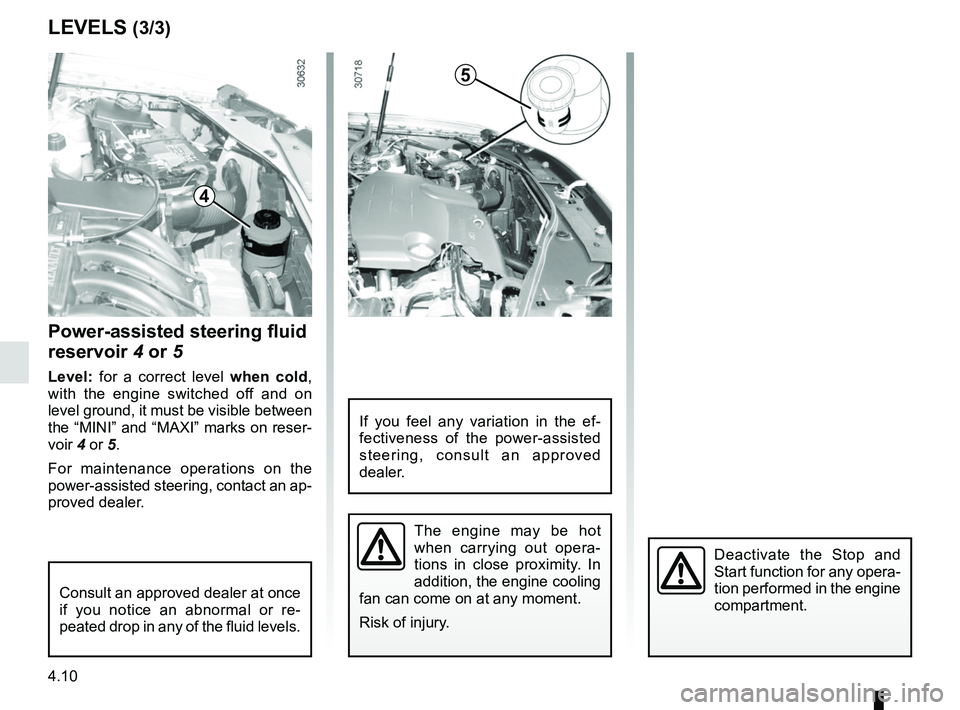
4.10
LEVELS (3/3)
Power-assisted steering fluid
reservoir 4 or 5
Level: for a correct level when cold,
with the engine switched off and on
level ground, it must be visible between
the “MINI” and “MAXI” marks on reser-
voir 4 or 5.
For maintenance operations on the
power-assisted steering, contact an ap-
proved dealer.
The engine may be hot
when carrying out opera-
tions in close proximity. In
addition, the engine cooling
fan can come on at any moment.
Risk of injury.
Consult an approved dealer at once
if you notice an abnormal or re-
peated drop in any of the fluid levels.
If you feel any variation in the ef-
fectiveness of the power-assisted
steering, consult an approved
dealer.
5
4
Deactivate the Stop and
Start function for any opera-
tion performed in the engine
compartment.
Page 169 of 256

4.11
FILTERS
The replacement of filter elements (air
filter, passenger compartment filter,
diesel filter, etc.) is scheduled in the
maintenance operations for your vehi-
cle.
Replacement intervals for filter el-
ements: refer to the Maintenance
Document for your vehicle.
Passenger compartment filter
If your vehicle is not originally fitted with
a passenger compartment filter, it is
possible to have one retrofitted.
Contact an approved dealer.
The engine may be hot
when carrying out opera-
tions in close proximity. In
addition, the engine cooling
fan can come on at any moment.
Risk of injury.
Air filter
If fitted to the vehicle, clogging sensor 1
allows you to see the condition of the
air filter.
Replacement of the filter is scheduled
in the maintenance operations: refer to
your vehicle’s Maintenance Document
for your vehicle.
However, it must be checked regularly,
especially if you drive in dusty environ-
ments.
If clogging level indicator 2 reaches
100%, consult an approved dealer as
soon as possible to have the filter re-
placed.
Resetting the air filter clogging
sensor
Once the air filter has been replaced,
turn button 3 on the clogging sensor
fully (movement A).
1
2
3
A
Deactivate the Stop and
Start function for any opera-
tion performed in the engine
compartment.
Page 172 of 256
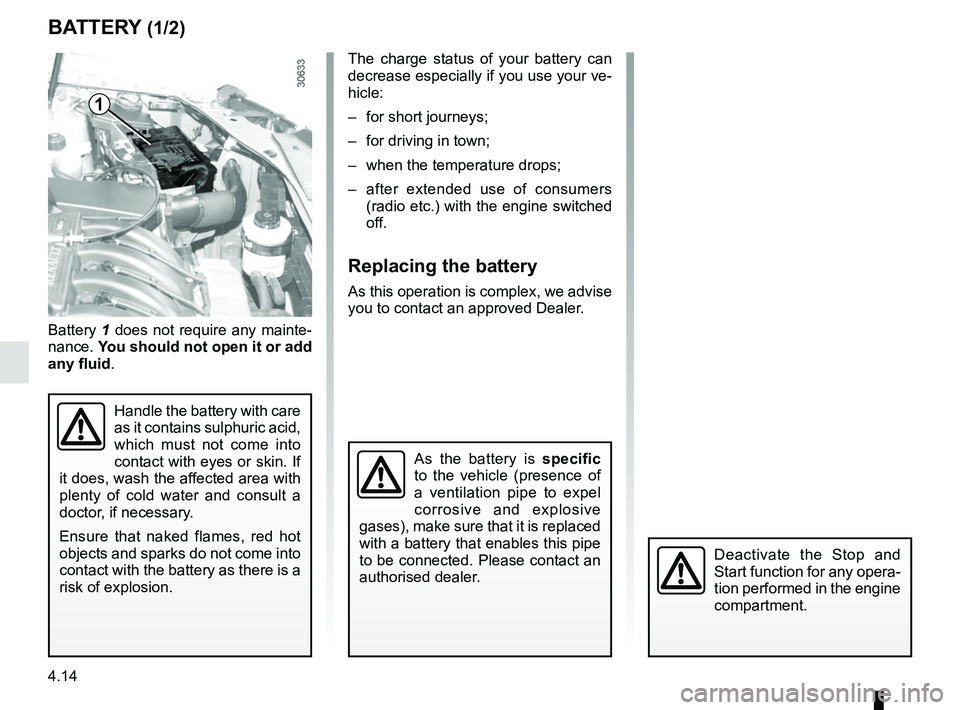
4.14
BATTERY (1/2)
Battery 1 does not require any mainte-
nance. You should not open it or add
any fluid .
Handle the battery with care
as it contains sulphuric acid,
which must not come into
contact with eyes or skin. If
it does, wash the affected area with
plenty of cold water and consult a
doctor, if necessary.
Ensure that naked flames, red hot
objects and sparks do not come into
contact with the battery as there is a
risk of explosion.
1
The charge status of your battery can
decrease especially if you use your ve-
hicle:
– for short journeys;
– for driving in town;
– when the temperature drops;
– after extended use of consumers (radio etc.) with the engine switched
off.
Replacing the battery
As this operation is complex, we advise
you to contact an approved Dealer.
As the battery is specific
to the vehicle (presence of
a ventilation pipe to expel
corrosive and explosive
gases), make sure that it is replaced
with a battery that enables this pipe
to be connected. Please contact an
authorised dealer.
Deactivate the Stop and
Start function for any opera-
tion performed in the engine
compartment.
Page 186 of 256
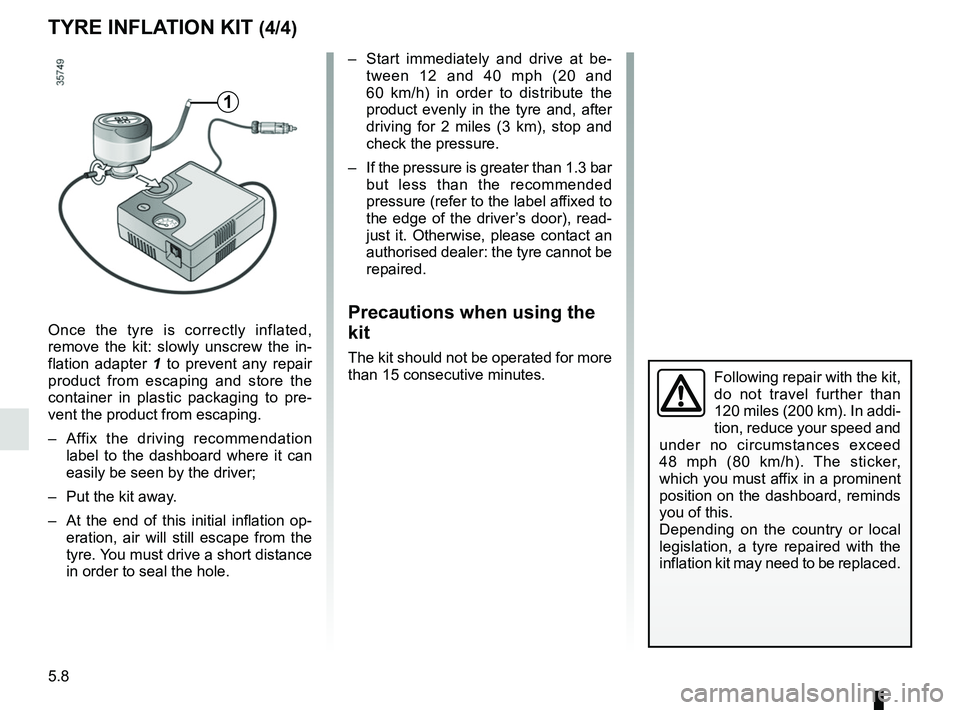
5.8
TYRE INFLATION KIT (4/4)
Once the tyre is correctly inflated,
remove the kit: slowly unscrew the in-
flation adapter 1 to prevent any repair
product from escaping and store the
container in plastic packaging to pre-
vent the product from escaping.
– Affix the driving recommendation label to the dashboard where it can
easily be seen by the driver;
– Put the kit away.
– At the end of this initial inflation op- eration, air will still escape from the
tyre. You must drive a short distance
in order to seal the hole.
– Start immediately and drive at be-tween 12 and 40 mph (20 and
60 km/h) in order to distribute the
product evenly in the tyre and, after
driving for 2 miles (3 km), stop and
check the pressure.
– If the pressure is greater than 1.3 bar but less than the recommended
pressure (refer to the label affixed to
the edge of the driver’s door), read-
just it. Otherwise, please contact an
authorised dealer: the tyre cannot be
repaired.
Precautions when using the
kit
The kit should not be operated for more
than 15 consecutive minutes.
1
Following repair with the kit,
do not travel further than
120 miles (200 km). In addi-
tion, reduce your speed and
under no circumstances exceed
48 mph (80 km/h). The sticker,
which you must affix in a prominent
position on the dashboard, reminds
you of this.
Depending on the country or local
legislation, a tyre repaired with the
inflation kit may need to be replaced.
Page 207 of 256
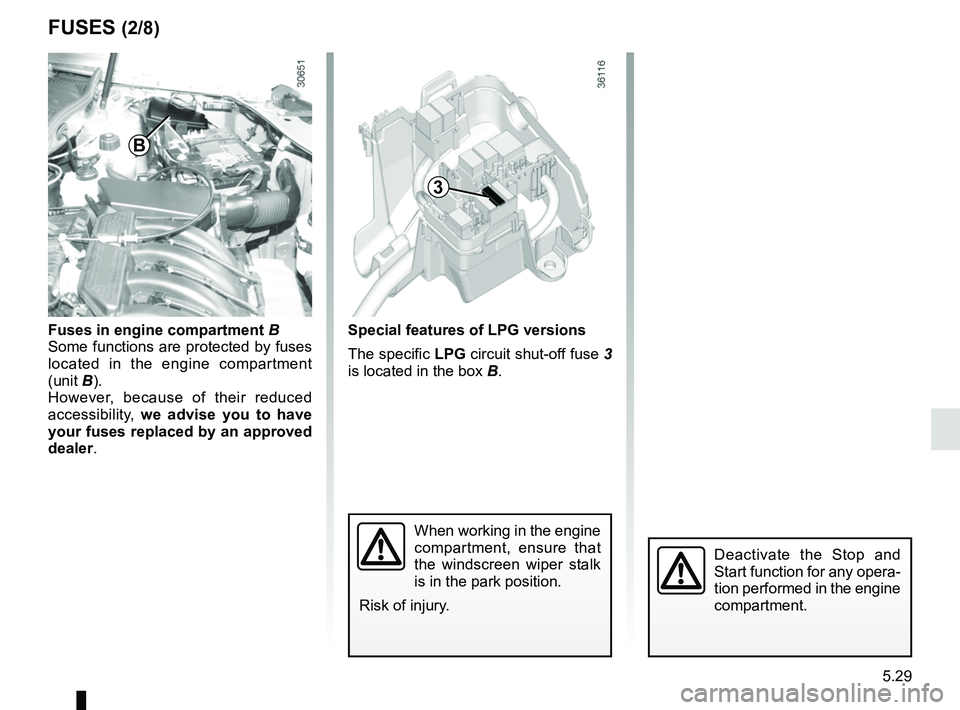
5.29
FUSES (2/8)
Fuses in engine compartment B
Some functions are protected by fuses
located in the engine compartment
(unit B).
However, because of their reduced
accessibility, we advise you to have
your fuses replaced by an approved
dealer.
B
Special features of LPG versions
The specific LPG circuit shut-off fuse 3
is located in the box B.
3
When working in the engine
compartment, ensure that
the windscreen wiper stalk
is in the park position.
Risk of injury.
Deactivate the Stop and
Start function for any opera-
tion performed in the engine
compartment.
Page 214 of 256
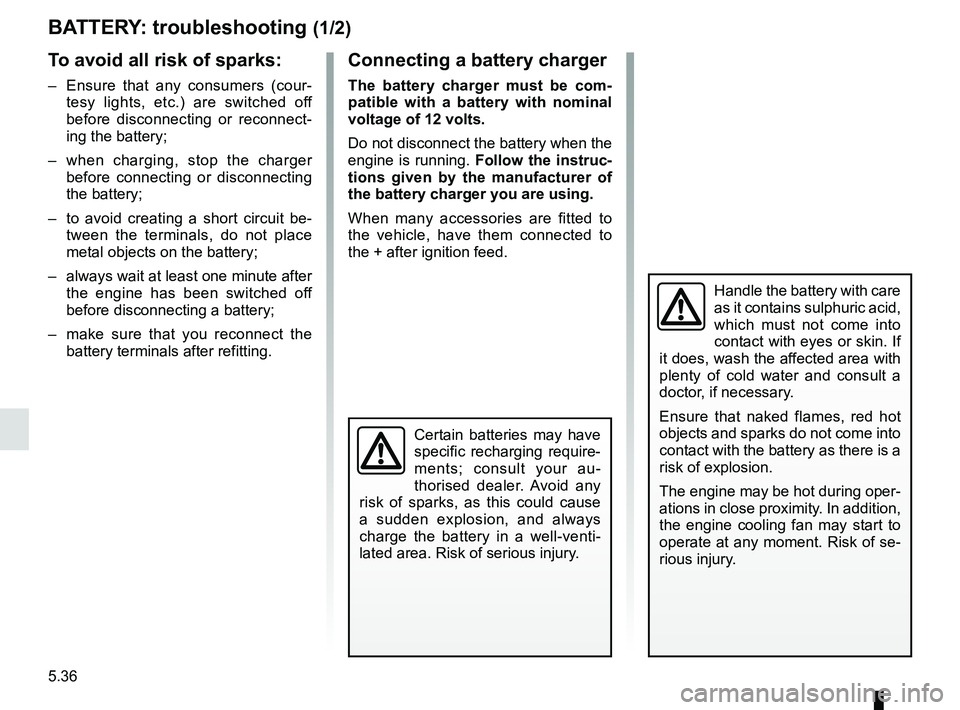
5.36
BATTERY: troubleshooting (1/2)
To avoid all risk of sparks:
– Ensure that any consumers (cour- tesy lights, etc.) are switched off
before disconnecting or reconnect-
ing the battery;
– when charging, stop the charger before connecting or disconnecting
the battery;
– to avoid creating a short circuit be- tween the terminals, do not place
metal objects on the battery;
– always wait at least one minute after the engine has been switched off
before disconnecting a battery;
– make sure that you reconnect the battery terminals after refitting.
Handle the battery with care
as it contains sulphuric acid,
which must not come into
contact with eyes or skin. If
it does, wash the affected area with
plenty of cold water and consult a
doctor, if necessary.
Ensure that naked flames, red hot
objects and sparks do not come into
contact with the battery as there is a
risk of explosion.
The engine may be hot during oper-
ations in close proximity. In addition,
the engine cooling fan may start to
operate at any moment. Risk of se-
rious injury.
Certain batteries may have
specific recharging require-
ments; consult your au-
thorised dealer. Avoid any
risk of sparks, as this could cause
a sudden explosion, and always
charge the battery in a well-venti-
lated area. Risk of serious injury.
Connecting a battery charger
The battery charger must be com-
patible with a battery with nominal
voltage of 12 volts.
Do not disconnect the battery when the
engine is running. Follow the instruc-
tions given by the manufacturer of
the battery charger you are using.
When many accessories are fitted to
the vehicle, have them connected to
the + after ignition feed.
Page 223 of 256

5.45
OPERATING FAULTS (1/5)
The following advice will enable you to carry out quick, temporary repai\
rs. For safety reasons you should always contact
an approved dealer as soon as possible.
The starter is activatedPOSSIBLE CAUSESWHAT TO DO
Warning lights dim or fail to come on;
the starter does not run. Battery terminals disconnected,
oxidised or incorrectly secured.Retighten them, reconnect them or clean
them if they are oxidised.
Battery discharged or worn. Connect another battery to the faulty bat-
tery. Refer to the information on “Battery:
troubleshooting” in Section 5 or replace the
battery if necessary.
Do not push the vehicle if the steering
column is locked.
The engine will not start. Starting conditions are not fulfilled.Refer to the information on “Starting/stop-
ping the engine in Section 2.
The steering column remains locked. Steering wheel locked. To unlock, gently move the key and the
steering wheel (refer to the information on
the “Ignition switch” in Section 2).
Page 252 of 256

7.4
ALPHABETICAL INDEX (4/5)
remote control door lockingbatteries ..............................................................\
......... 5.38
remote control door locking unit ................................1.2 → 1.4
remote engine start-up ............................................... 1.2 – 1.3
RENAULT ANTI-INTRUDER DEVICE (RAID) ..................... 1.7
replacement parts ................................................................ 6.8
reverse gear selecting ..............................................................\
......... 2.29
reversing sensor ..................................................... 2.49 – 2.50
roof bars ........................................................................\
.... 3.28
roof rack roof bars ....................................................................... 3.28
running in ........................................................................\
..... 2.2
S
seat belts ...............................................................1.13 → 1.21
service sheets..........................................................\
6.9 → 6.14
signals and lights .................................................... 1.59 – 1.60
speakers location ...............................................................\
......... 5.43
special features of diesel versions.....................................\
2.11
special features of LPG versions ..... 2.12 → 2.14, 5.28 → 5.35
special features of petrol vehicles ..................................... 2.10
speed limiter ..........................................................2.38 → 2.40
starting ...............................................................\
........2.3 → 2.6
starting the engine .....................................................2.2 → 2.9
steering wheel adjustment .............................................................\
...... 1.56
Stop & Start ...............................................................2.7 → 2.9
Stop & Start function..................................................2.7 → 2.9
storage compartment.............................................3.16 → 3.19
storage compartments ...........................................3.16 → 3.19
sun visor ........................................................................\
.... 3.13
T
tailgate ...............................................................\
....3.23 → 3.25tanks and reservoirs
brake fluid ...................................................................... 4.8
coolant ................................................................\
........... 4.9
tanks and reservoirs: windscreen washer ...................................................... 4.10
technical specifications .......................................6.2, 6.6 → 6.8
telephone ..............................................................\
............. 3.29
towing .................................................................\
................. 6.7 breakdown .......................................................5.40 → 5.42
towing equipment ......................................................... 3.26
towing a caravan ................................................................. 6.7
towing hitch............................................................\
5.40 → 5.42
towing rings ............................................................ 3.24 – 3.25
towing weights ..................................................................... 6.7
traction control .......................................................2.34 → 2.37
transporting children ..............................................1.22 → 1.32
transporting objects in the luggage compartment ............................. 3.24 – 3.25
trims ..................................................................\
................... 5.9
trip computer and warning system.........................1.50 → 1.55
tyre inflation kit......................................................\
.....5.5 → 5.8
tyre pressure.............................2.22 → 2.28, 4.12 – 4.13, 5.13
tyre pressure loss warning.....................................2.22 → 2.28
tyre pressures ......................................................... 4.12 – 4.13
tyres ............................. 2.22 → 2.28, 4.12 – 4.13, 5.12 → 5.15
V
variable power-assisted steering ....................................... 1.56
vehicle identification ............................................................ 6.2
vehicle identification plates ........................................6.2 → 6.4
ventilation air conditioning ...................................................... 3.2 – 3.3
heating and air conditioning system ....................3.4 → 3.7
W
warning buzzer .................................................................. 1.60